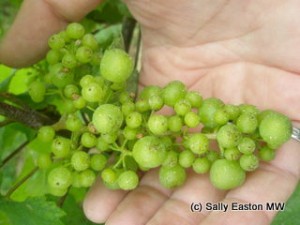Coulure and millerandage

Coulure - gaps where no berries have formed. Millerandage - small, seedless berries amid a few normal berries.
These two little issues have cropped up in several places in Europe in vintage 2012. They often go hand in hand, and they are usually referred to by their French names.
They are flowering and fruitset issues that arise as the result of poor weather at flowering, especially in cooler climates. Successful fruitset is the development of a single grape berry from a single flower, but few flowers open at temperatures less than 15°C.
Eric Szablowski, ex-William Fevre cellar master for 23 years, in Chablis explained “usually flowering happens in one week. The temperature was low this year, and there was a lot of rain” which hampered pollination. He added “this year flowering took two weeks, and with great irregularity.” Other parts of northern France, and the UK suffered pretty similar flowering conditions.
Ideally flowering is quick and synchronous resulting in an even fruitset, which then goes on to ripen pretty much all at the same time. With the very long flowering, Szablowski said “there are lots of small berries, with coulure and millerandage. We might have many different levels of ripeness in the same bunch.” This makes harvest decisions challenging, to say the least.
Coulure, or poor set, Szablowski explained is when “there is no fertilisation, no grape”, resulting in fewer berries per bunch. Millerandage on the other hand “is a poor fertilisation, giving small grapes”, without seeds, though which still have the capability to mature and ripen. These exist on the same bunch as successfully set berries.
Millerandage is sometimes referred to as ‘hen and chicken’, where hen berries (the bigger ones) are the result of normal fruitset. Hen berries contain seeds. Chicken berries (the smaller ones) are the seedless berries, which are still able to ripen normally.
Yield is inevitably lower than normal when these conditions arise. But if subsequent conditions are favourable, fruit may be well concentrated. A proportion of coulure and millerandage is not necessarily a bad thing for the quality of the final crop.



